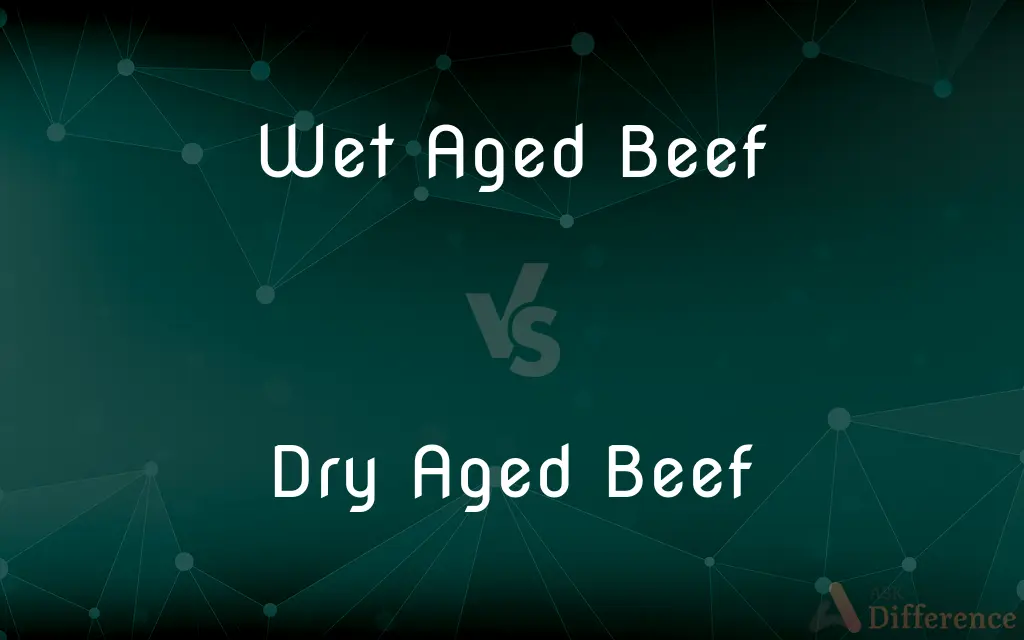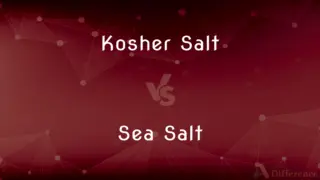Wet Aged Beef vs. Dry Aged Beef — What's the Difference?
By Urooj Arif & Maham Liaqat — Published on April 14, 2024
Wet Aged Beef is vacuum-sealed and aged in its juices, offering tenderness without altering flavor significantly. Dry Aged Beef is exposed to air, concentrating flavor and enhancing texture over time.

Difference Between Wet Aged Beef and Dry Aged Beef
Table of Contents
ADVERTISEMENT
Key Differences
Wet Aging is a process where beef is aged in a vacuum-sealed bag, keeping it in contact with its natural juices, which helps in tenderizing the meat over a period typically ranging from a few days to a few weeks. On the other hand, Dry Aging involves hanging the meat or placing it on racks in a controlled environment (with specific temperature, humidity, and air circulation) for several weeks or even months.
The Wet Aging process is more cost-effective and less time-consuming than Dry Aging. Wet Aging requires less specialized equipment and space, and the absence of moisture loss means there's no reduction in the weight of the beef, which can affect the final cost. Conversely, Dry Aging is more expensive due to the significant weight loss from moisture evaporation (up to 20% or more) and the need for controlled aging conditions, which also results in a higher price per pound for consumers.
Wet Aged Beef tends to have a more mild and clean taste, reflecting the meat's natural flavors without significant alteration. In contrast, Dry Aged Beef develops a more concentrated and robust flavor profile, often described as nutty or even cheesy, which is highly prized by connoisseurs. This distinctive taste is a result of the natural enzymatic and microbial processes that occur during the aging period.
The texture of Wet Aged Beef remains relatively similar to fresh beef, albeit more tender due to the enzymatic breakdown occurring within the vacuum-sealed environment. Dry Aged Beef, however, undergoes a more extensive transformation, becoming significantly more tender and developing a texture that some describe as "buttery" due to the concentration of flavors and breakdown of muscle fibers and connective tissues.
Choosing between Wet Aged and Dry Aged Beef often comes down to personal preference and the occasion. Wet Aged Beef is widely available and suits everyday cooking, offering a balance of flavor and tenderness at a more affordable price. Dry Aged Beef, with its unique flavor profile and tender texture, is often reserved for special occasions or fine dining experiences, reflecting its gourmet status and higher cost.
ADVERTISEMENT
Comparison Chart
Aging Process
Vacuum-sealed in its juices
Exposed to air in a controlled environment
Flavor Development
Maintains original flavor, slightly intensified
Concentrated beefy flavor with unique taste notes
Texture
More tender than fresh beef, but similar texture
Becomes significantly more tender, often "buttery"
Cost
More cost-effective due to no weight loss
Higher due to weight loss and specialized processing
Availability
Common in supermarkets and standard butcheries
Typically found in specialty stores or high-end restaurants
Compare with Definitions
Wet Aged Beef
Tenderizes without altering flavor significantly.
Wet aged beef maintains a fresh, clean taste.
Dry Aged Beef
Exposed to air in a controlled environment.
Dry aging enhances beef's flavor through moisture evaporation.
Wet Aged Beef
Popular for everyday meals.
Its balance of tenderness and flavor suits a variety of dishes.
Dry Aged Beef
Results in a tender, "buttery" texture.
The texture of dry aged beef is unparalleled in its tenderness.
Wet Aged Beef
Aged in vacuum-sealed packaging.
Wet aged beef retains moisture for enhanced tenderness.
Dry Aged Beef
Reserved for special occasions or fine dining.
Dry aged beef is often featured in gourmet culinary experiences.
Wet Aged Beef
More economical, with less processing required.
The cost-effectiveness of wet aging makes it widely accessible.
Dry Aged Beef
Requires more time and specialized facilities.
The process contributes to the premium price of dry aged beef.
Wet Aged Beef
Shorter aging period.
Wet aged beef is often ready for consumption after a few weeks.
Dry Aged Beef
Develops a rich, concentrated flavor profile.
The unique taste of dry aged beef is sought after by enthusiasts.
Common Curiosities
Why is Dry Aged Beef more expensive?
The process involves weight loss through moisture evaporation and requires controlled conditions, increasing its cost.
Is Wet Aged Beef tender?
Yes, it becomes more tender than fresh beef due to enzymatic action but is generally not as tender as Dry Aged Beef.
How long is beef usually wet aged?
Beef is typically wet aged for a few days to a few weeks, depending on desired tenderness.
Does Wet Aged Beef have a distinct smell?
Wet Aged Beef does not develop the strong aroma that Dry Aged Beef can, as it is sealed from air exposure.
Can you taste the difference between Wet and Dry Aged Beef?
Yes, Dry Aged Beef has a more pronounced and unique flavor profile compared to the milder taste of Wet Aged Beef.
What is Wet Aged Beef?
Wet Aged Beef is beef that has been aged in a vacuum-sealed bag, allowing it to tenderize in its own juices.
How is Dry Aged Beef different?
Dry Aged Beef is aged exposed to air, which concentrates its flavor and enhances tenderness over a longer period.
What is the longest you can dry age beef?
Beef can be dry aged for several weeks to months; some cuts are aged for up to 120 days or more.
How do chefs prefer to cook Dry Aged Beef?
Chefs often cook Dry Aged Beef with simple seasoning to let its unique flavors stand out, usually by grilling or pan-searing.
Is Dry Aged Beef safe to eat?
Yes, when processed in controlled conditions by professionals, Dry Aged Beef is safe and highly regarded for its flavor.
Can I age beef at home?
Wet aging at home is relatively simple with vacuum-sealing equipment, but dry aging requires specific conditions that are hard to replicate safely at home.
Is the nutritional value different between Wet and Dry Aged Beef?
The nutritional value is relatively similar, though Dry Aged Beef may have a slightly higher concentration of nutrients due to moisture loss.
Where can I buy Dry Aged Beef?
It's usually available at specialty butcher shops or high-end grocery stores, and often featured in fine dining restaurants.
Why does Dry Aged Beef sometimes have a funky flavor?
The dry aging process can develop bold and complex flavor notes, sometimes described as nutty or cheesy, due to enzymatic and microbial activities.
Can Wet Aged Beef be used for any recipe?
Yes, Wet Aged Beef is versatile and can be used in a wide range of recipes just like fresh beef.
Share Your Discovery

Previous Comparison
Lavender vs. Violet
Next Comparison
Kosher Salt vs. Sea SaltAuthor Spotlight
Written by
Urooj ArifUrooj is a skilled content writer at Ask Difference, known for her exceptional ability to simplify complex topics into engaging and informative content. With a passion for research and a flair for clear, concise writing, she consistently delivers articles that resonate with our diverse audience.
Co-written by
Maham Liaqat












































